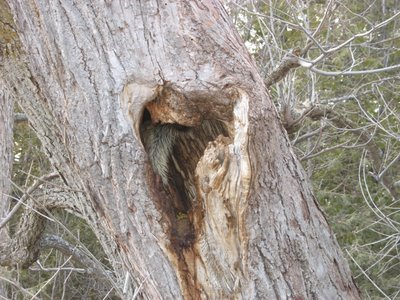hopelessly distracted







I am under a spell, bewitched.
The sun was shining. The cool spring air was mild and soft. Patches of snow still lay on the ground where the drifts had been deep, where trees keep the snow in shade, the shrinking patches of snow grainy, slippery and heavy.
Where fallen logs lay on the ground along hedgerows and in the woods, they are blanketed with mossy green. Satiny frills of brown lichen, flash an orange lining, like the skirts of some unknown tribal dress. Other lichens like old, grey, tattered lace doilies spread themselves over a sunny rock. On the sunny side of tree trunks and on rocks baking in the sun, splotches of orange , chartreuse and veridian amongst the grey lichens are scattered about as if a mad painter had carelessly splattered his paints or marked things with fading slashes of colour: mine, mine, mine, mine. This tree, and this rock, and this, and this, and this, too.
On my hands and knees, engrossed in the miniature forest of moss, exotic fronds, tiny, capped urns atop hair-like stalks, lacy carpets with ferny swirling patterns, grey lichen cathedral ruins with pillars reaching for the sky, grey and verdigris saucers of a space-age city-scape, the giant, friendly body of my English bulldog, intrudes on my miniature world as she thrusts, snuffling, into my face.
"There you are! Come on! I love you (lick, lick). You’re falling behind. We were way up ahead on the path. We came back for you! Come on!" She lunged at me, a goofy hockey-player, affectionately body-checking me.
Struggling to regain my balance, my focus lifts momentarily from the complex, micro world of mosses and lichens to the larger universe: mild spring air, sunny blue skies, brown meadows, mats of crisp, dry leaves in the hedgerows, bare trees overhead, buds swelling on the tips of the branches, ruby, gold, jade, amber.
The insistent "pee-eep!" of the nuthatch and the quarrelsome "peek, peek, peek" of the hairy woodpecker turn my head upwards. Chickadees have come along too, curious, checking up on the activities of the intruders, all the while busy snacking on all the foodstuff in the crevices of the tree bark. The loud, ringing "kik-kikkik, kik-kik" of the pileated woodpecker announces his passage and I catch a glimpse of white the underwings of the large, black bird, then the flaming-red crest on his head as he swoops up into the naked tree-tops. Trying to approach closer for a better look at him, I only elicit an angry "kik, kikkik,kikkik" and he swoops off through the trees and away.
The dogs come back again, circling around me, sniffing the ground.
"Huh? What has distracted her this time? I don’t smell anything new here, do you?"
"Come on. Catch up with us. There’s this great scent up ahead and we want to know where it leads! Come on!"
Happily, I wander on, drinking in the day: the smell of dank, rich earth and water, the sound of soft wind sighing through the trees, melting runoff gurgling over the lip of the culvert into the ditch, the visual riches of bare trees silhouetted against the blue sky, many textured bark, the sensations of dry leaves, spongy soil, heavy snow, crunchy gravel or melted-chocolate, smeary mud under my boots.
This warm spring afternoon has captured my soul and stolen it away. Gone, it's gone!




















 .
.














 In contrast, this is today. The snow and ice are melting fast, revealing all sorts of grossness (ie. dog-doo-doo) as they melt away. (Notice I adroitly I avoided showing you that stuff?) The good news is that the melting is also revealing some small tips of growing stuff: my bulbs planted at the east side of the house by the "back door" are coming up. Some of the perennials came through the winter quite well and already green, are just waiting to shake off the rest of the snow to grow in earnest.
In contrast, this is today. The snow and ice are melting fast, revealing all sorts of grossness (ie. dog-doo-doo) as they melt away. (Notice I adroitly I avoided showing you that stuff?) The good news is that the melting is also revealing some small tips of growing stuff: my bulbs planted at the east side of the house by the "back door" are coming up. Some of the perennials came through the winter quite well and already green, are just waiting to shake off the rest of the snow to grow in earnest.










